Shooting steel targets is usually a game changer for many shooting sports and recreational shooters. Don’t get me wrong punching paper is still great for zeroing sights and a fun day at the range. But shooting steel gives you immediate feedback on the line, and far less clean up.
A lot goes into picking out the right steel for your needs. Type of steel, thickness, and shooting distance all play a role. I’ve spent thousands on steel targets over the years, made mistakes, and learned a lot. Here’s everything you need to know about shooting steel.
See full reviews and testing of the most recommended steel targets below.
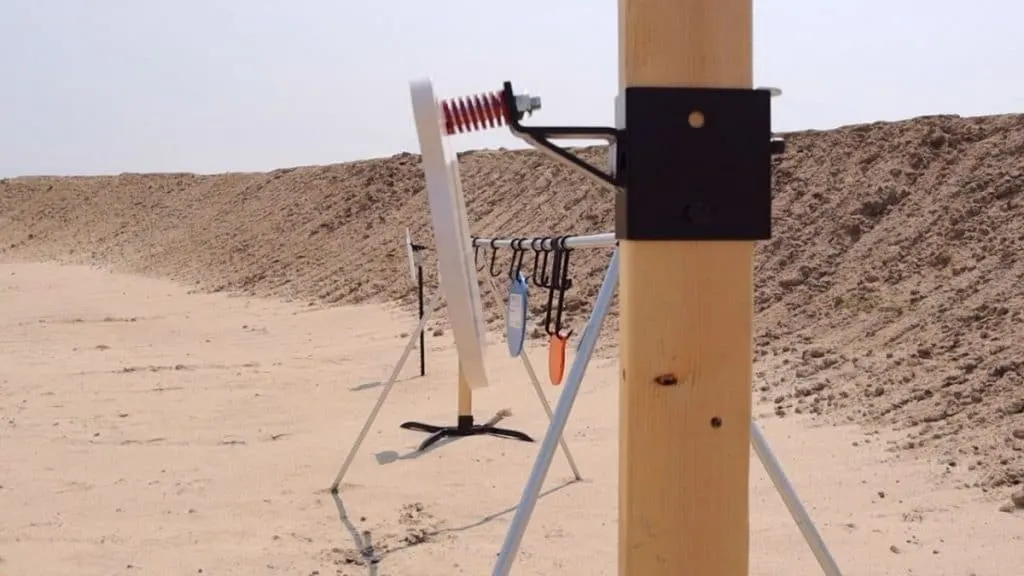
What Kind of Steel for Shooting Targets
The steel used for shooting targets is usually made of AR500 or AR550 steel. AR400 steel is sometimes used for low velocity rimfire ammunition, and AR550 steel is recommended for high powered rifle ammunition. The most popular steel for shooting targets is 3/8″ thick AR500 steel plates.
Shooting target steel needs to be strong enough to handle a bullet impact without pitting, warping, or incurring excessive damage. An AR500 steel means it has a Brinell hardness rating of at least 500. The Brinell test is the industry standard for testing steel hardness.
Reference chart for steel shooting target type:
| 1/4″ AR500 | 3/8″ AR500 | 3/8″ AR550 | 1/2″ AR550 |
|---|---|---|---|
| Rimfire Pistol | Centerfire Handgun | Centerfire Rifle | Big Bore Rifle |
| .22LR Pistol | 9mm Luger | 5.56/.233 | .338 Lapua |
| .45 ACP | 7.62/.308 | .50 BMG | |
| .44 Mag | 300 Win Mag | ||
| Rimfire Rifle | Shotgun Shot | Shotgun Slug | |
| .22LR Rifle | 12 Gauge Bird Shot | 12 Gauge Slug | |
| 12 Gauge Buck Shot | |||
| 10 Yards Minimum | 10 Yards Minimum | 100 Yards Minimum | 100 Yards Minimum |
Manufacturers of steel targets may rate their steel differently. For example, I’ve seen 3/8″ AR500 being sold as suitable for .233 or .308 at 100 yards. When I tried that though, I ruined the steel. This chart is just from my experience and what I’ve seen work best first hand.
What Are Steel Targets Made of
Steel targets are made of a through steel that has the proper amount of carbon, alloying elements, and has undergone a specific heating and cooling process to ensure a certain hardness rating. Steel targets are most often made out of AR500 or AR550 hardened steel.
How Thick Should Steel Targets Be
Steel target thickness is determined by the type of ammunition being fired at it. Low velocity ammunition will only require 1/4″ steel plates. While larger handgun and rifle rounds will require 3/8″ steel plates. Higher velocity or magnum rifle rounds may even require 1/2″ steel plates to shoot safely.
The distance you shoot the steel targets from will also determine which thickness and steel hardness you need. Since rounds will lose more velocity at greater distances, the impact they have on the steel targets will be less.
How Far Away To Shoot Steel Targets
It is recommended to shoot rimfire pistol, rimfire rifle, centerfire handgun, and shotgun shot at 10 yards or greater. 100 yards or greater is required when shooting centerfire rifle, shotgun slug, or big bore rifles. With rounds traveling over 3000 fps, 160 yards or more is recommended.
The quality and thickness of your steel will also determine how far away you’ll want to be shooting. For example, with 3/8″ AR500 steel I would want to shoot .223/5.56 around 200 yards, but with AR550 steel, I would be comfortable moving up to 100 yards.
How Close Can You Shoot Steel Targets
When shooting rimfire or centerfire handgun at properly rated steel shooting targets, manufacturers state, you can safely shoot as close as 10 yards. When shooting centerfire rifle or big bore rifles at properly rated steel targets, you can safely shoot as close as 100 yards.
Of course shooting steel is never 100% safe from risk. But staying the recommended distances away when shooting and using the right steel mounted the right way, will almost guarantee you’ll never have an issue.
What Size Steel Target for Pistol
The optimal size steel target for pistol shooting at 10 yards is a 6″ AR500 3/8″ thick steel target. If shooting at 25 yards or greater 8″, 10″, or 12″ becomes more desirable. Starting with larger steel plates and moving to smaller ones is a good way to train with a pistol.
I prefer using this Handgun Dueling Tree (link to Amazon) that comes with with 6″ AR500 steel plates when shooting pistol at 10 yards. I’ll use 10″ hanging steel targets if I move a little further out.
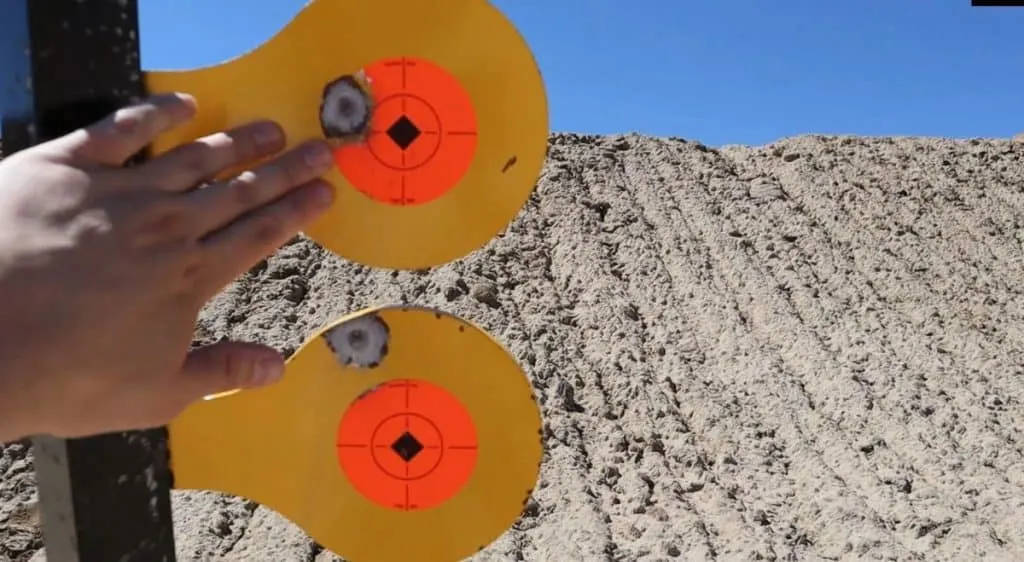
It’s best to use what you’re comfortable with and are able to hit consistently. You can always move further away or get smaller targets as you improve.
What Size Steel Target for 100 Yards
The optimal size of steel target for shooting at 100 yards is 10″ gong, 12″ gong or a 12″x20″ silhouette. Many precision shooters will be fine with a 6″ or 4″ target if they consistently shoot 1 MOA or less. 20″ or larger steel targets are better for pistol shooting at 100 yards.
When shooting a centerfire rifle at 100 yards I prefer to have a couple silhouette targets up and then an 8″ and 10″ gong as well. I do also have some 6″ gongs set up for when I pull out the bolt action .308 to practice accuracy.
I use this Steel Shooting Combo Pack (link to Amazon) because it has the silhouette and a couple gongs included which are perfect for 100 yard shooting.

What Size Steel Target for 1000 Yards
The optimal size steel target for shooting at 1000 yards is an 18″ by 18″ square. At the very least a 10″ gong should be used since 10″ at 1000 yards is 1 MOA. Beginner level shooters should consider using a 20″ by 20″ square or larger at 1000 yards, adding smaller targets as they improve.
Do Steel Targets Ricochet
Steel targets are made to ricochet a bullet after being hit. Steel targets ricochet the bullet in a safe direction when they can move or swing after being hit or mounted at a downward angle. Pitting, indents, and imperfections in the steel surface can cause ricochets in unwanted directions.
It’s important to use the proper hardness of steel for what you’ll be shooting and to make sure the steel targets are hung or mounted correctly to avoid any dangerous ricochets. Soft steel and any steel that does not have a completely flat shooting surface could send ricochets back at the shooter or bystanders.
How To Hang Steel Targets
To hang steel targets, use a 2×4 or EMT frame with chains, rubber straps, or steel target hangers. Chains and rubber straps require carriage bolts to connect the steel targets to the frame. The steel targets must be able to swing or move freely for them to deflect bullets safely.
I’ve used chains, rubber straps, and steel target hangers and I prefer the target hangers above all other options. Chains are easy to shoot by accident and need frequent replacing. The rubber straps mostly solve that problem because they can take a few hits, but eventually need replacing as well.
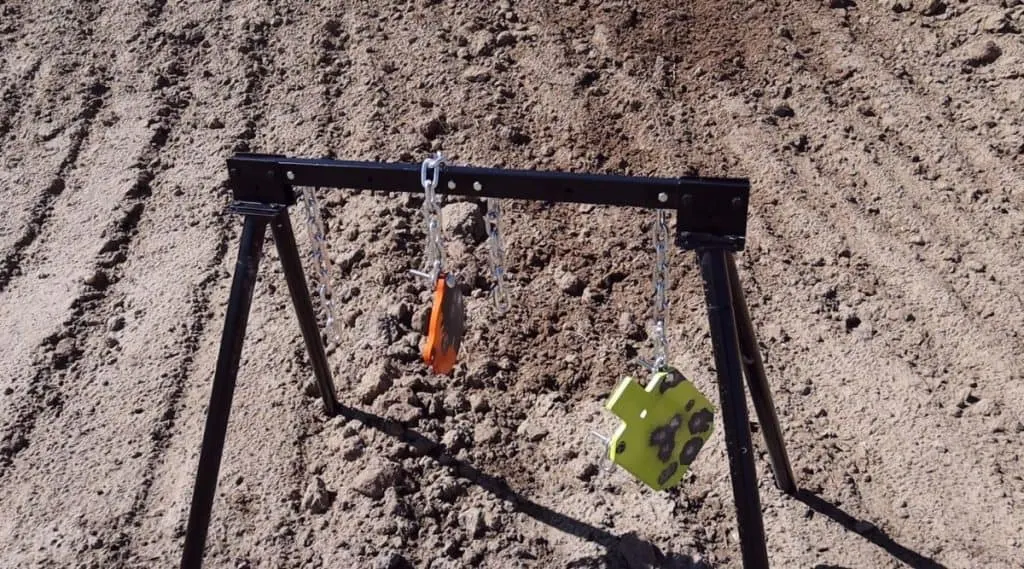
These AR500 Steel Target Hangers (link to Amazon) last a lot longer than any other option I’ve found and they don’t require carriage bolts or tools to swap them out.
They make target hangers that slide onto 2×4’s or pieces of EMT found at any home improvement store. Now that I found these, I’ll never use chains again.
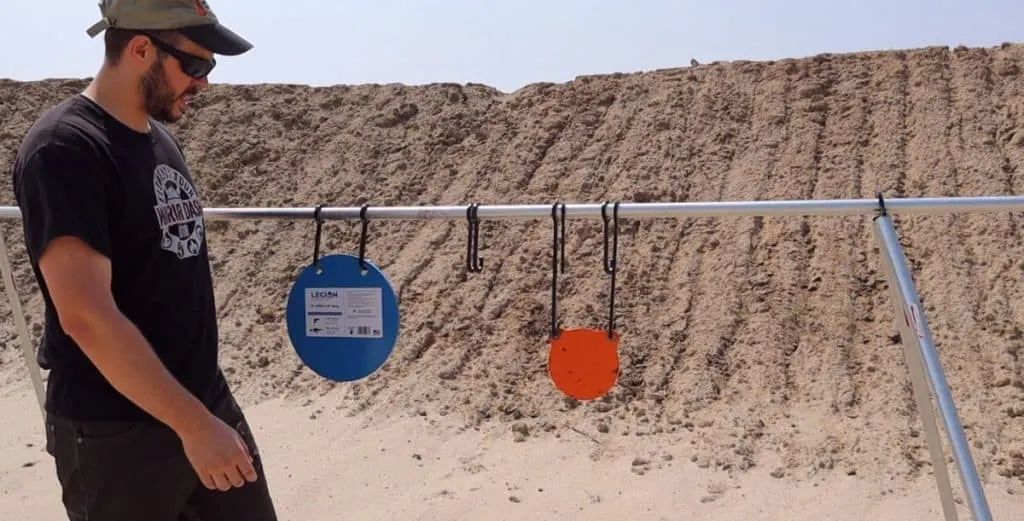
How To Mount Steel Targets
The most common way to mount steel targets is to a 2×4 or T-post using target mounting brackets. The mounting bracket is installed onto a 2×4 or T-post, and the target is affixed to the mounting bracket at the correct angle for the bullets to deflect in a safe direction.
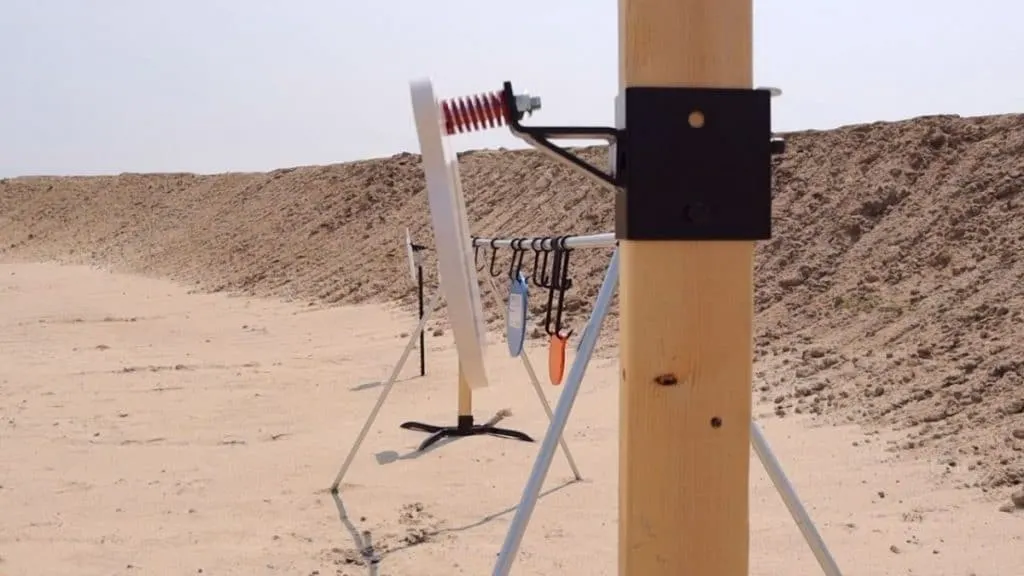
I have targets mounted on T-posts and on 2×4’s and haven’t had any problems with either. The 2×4 does require a base where the T-post can just be hammered into the ground. The T-post is made out of softer steel so you have to be careful not to shoot it.
I like this Target Stand Mount when using 2×4’s and this T-post Plate Mount when using a T-post. Both options come with the compression spring and hardware to angle the steel correctly.
How To Angle Steel Targets
Steel targets should be angled towards the ground at a 20 degree downward angle or greater to deflect shrapnel and bullets safely into the ground. Mounting posts and hangers may need to be installed at an angle in order for the steel target to be angled in a safe direction.
Most 2×4 and T-post steel target mounts are angled correctly as long as the 2×4 or T-post is installed straight up and down. The compression spring has a little give so when the target takes a hit, it can move a little bit allowing the shrapnel and bullet to deflect away safely.
What To Shoot Steel Targets With
The best ammo type to shoot steel targets with is frangible ammo that will disintegrate upon impact. Frangible ammo will limit shrapnel and ricochet caused by shooting steel. FMJ is another popular ammo type for steel targets. Do not use armor piercing, steel core, or green tip ammo.
Although frangible ammo is best for shooting steel targets, it can be a bit more expensive and not easy to find sometimes. I usually shoot copper or synthetic jacketed ammo, and when using the right steel targets, never have an issue.
Do not use armor piercing, steel core, or green tip ammo. Shooting steel or armor piercing ammo at steel targets increases the chance of dangerous ricochets and shrapnel. Plus, those ammo types can damage your steel targets.
Can You Shoot FMJ at Steel Targets
You can shoot FMJ at steel targets safely if the targets are angled 20 degrees downward or able to swing when hit. Most FMJ ammo is copper or synthetic jacketed with a soft lead core and will break into pieces when impacting steel. Do not shoot steel core ammo at steel targets.
The safest way to shoot FMJ at steel targets is when the target is static and angled 20 degrees towards the ground. Steel targets that swing is also safe, but if the target is hit with a follow up shot while swinging back towards the shooter, there can be some ricochet or shrapnel.
Since FMJ breaks up into pieces upon impact, there may be some splash back with swinging targets hit at the right time. I’ve never been injured by any splash back but some small cuts or scrapes can happen. Always use AR500 or AR550 steel targets for the best results.
Can You Shoot Steel Targets With 22LR
You can safely shoot steel targets with a 22LR at distances greater than 10 yards if the steel target is angled downward at a 20 degree angle or able to swing. 22LR ammo with a bullet velocity lower than 400 feet per second is not recommended for shooting steel.
I know people that have used AR400 steel targets for their 22LR, but I still recommend only using AR500 or AR550 steel angled properly or able to move when hit. The good news is, with AR500 steel, you only need it to be 1/4″ thick to safely shoot 22LR at it.
Best Steel Targets: Hands-On Reviews
Best Steel Targets for Rifles
The best steel target for rifles is 1/2″ thick AR500 or AR550 steel targets. The size of target will depend on the skill of the shooter, but at 100 yards most people will have fun with a 12″ gong or 12″x20″ silhouette. If the targets will not be shot with big bore rifles, 3/8″ AR500 steel would also work.
I use this Steel Shooting Combo Pack (link to Amazon) because it has the silhouette and a couple gongs included which are perfect for 100 yard shooting.
Here’s a review video I made of these steel targets:
I also like these 1/2″ AR500 Steel Gong Targets (link to OpticsPlanet) for either mounting on a 2×4 target hanger or using on my frame target hanger.
For a 3/8″ AR500 target I would suggest looking at this Allen EZ-Aim Steel Gong (link to Amazon) the price is right for that one and here’s a review video of it:
Best Handgun Steel Targets
The best steel target for handguns is 1/4″ or 3/8″ thick AR500 steel targets. However, the thicker targets serve a double purpose as they will be useful for some rifle calibers as well. 6″ to 10″ gong targets are recommended for pistol shooting. 12″ or larger gong or silhouette targets are better for beginner or to move out past 25 yards with.
For a lot of fun pistol shooting, I would recommend this Handgun Dueling Tree (link to Amazon) that comes with with 6 AR500 steel plates 6″ in diameter. You could also use any of the targets above under the rifle section.
Here’s my review video of this dueling tree so you can see how it looks in action:
Another inexpensive option is the Highwild Steel Target Set (link to Amazon) that comes with a couple targets and the frame with chains to set it up all in one package.
Here’s my review video to give a better idea of using this set, as you can see I wouldn’t recommend shooting this set with .223 or .308:
You already know I recommend replacing the chains as soon as you can. But for a first target set to get you shooting steel, it’s not a bad way to go.
Best Steel Targets for .223 and 5.56
The best steel targets for .223 and 5.56 are made of AR550 steel and 3/8″ or 1/2″ thick. Some 3/8″ thick AR500 steel targets are rated for .223/5.56, but with most target ammo you have to shoot well over 150 yards away to avoid pitting the steel.
Best Steel Targets for 9mm
The best steel targets for 9mm are made of 3/8″ thick AR500 steel. The size of the target should be no smaller than 6″ diameter for shooting at 10 yards. Some manufacturers make 1/4″ thick AR400 steel targets rated for 9mm, but that is the bare minimum and not recommended for extended use.
